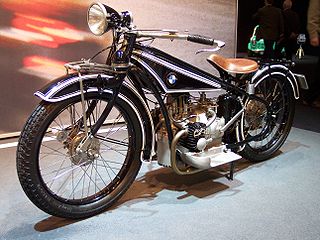
BMW's motorcycle history began in 1921 when the company commenced manufacturing engines for other companies. BMW's own motorcycles—sold under the BMW Motorrad brand—began in 1923 with the BMW R 32, which was powered by a flat-twin engine. Production of motorcycles with flat-twin engines continues to this day, however BMW has also produced many models with other types of engines.
The Honda XR series is a range of four-stroke off-road motorcycles that were designed in Japan but assembled all over the world.

The Suzuki Katana is a street motorcycle sold between 1981 and 2006 and then since 2019. It was designed in 1979–1980 by Target Design of Germany for Suzuki.

The BMW GS series of dual-sport BMW motorcycles have been produced from 1980, when the R80G/S was launched, to the present day. The GS originally stood for Gentleman's Scrambler, but was later renamed to Gelände/Straße. GS motorcycles can be distinguished from other BMW models by their longer travel suspension, an upright riding position, and larger front wheels – typically 19 to 21 inch. In May 2009, the 500,000th GS was produced, an R1200GS model.
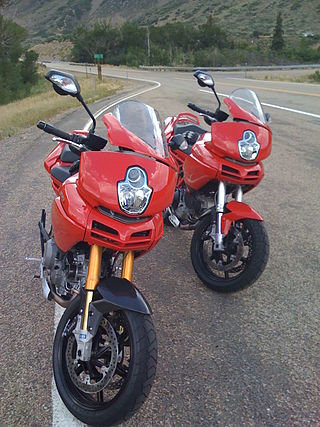
First introduced in 2003, the Ducati Multistrada is a series of V-twin and V4 touring focused motorcycles. Essentially a hybrid of a supermoto and a sport-tourer, the Multistrada competes in the market with other dual-sport motorcycles such as the BMW GS. The first iteration of the Multistrada was, like the Yamaha TDM850, neither intended nor suitable for off-road use. Subsequent models were more suited to a proper dual-sport role.

The BMW R90S is a 900cc sport motorcycle produced by BMW from 1973 to 1976. BMW commissioned designer Hans Muth to oversee the R90S, which became the flagship of the boxer engined "/6" range. Sporting distinctive two-tone paintwork, a bikini fairing and a new tail, the R90S was intended to shrug off the enduring image of BMW bikes as staid and utilitarian.

The Suzuki GSX-R750 is a sports motorcycle made by Suzuki since 1984. It was introduced at the Cologne Motorcycle Show in October 1984 as a motorcycle of the GSX-R series for the 1985 model year.
A motorcycle's suspension serves a dual purpose: contributing to the vehicle's handling and braking, and providing safety and comfort by keeping the vehicle's passengers comfortably isolated from road noise, bumps and vibrations.
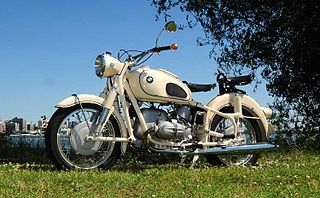
The R69S, R69US, and R69 are motorcycles, fitted with 594 cc boxer twin engines, that were manufactured by BMW in Munich, Germany.

The BMW R1100GS is a dual-sport motorcycle that was launched in 1993, and manufactured from 1994 to 1999 by BMW Motorrad in Berlin, Germany. The bike has a 1,085 cc (66.2 cu in) flat-twin (boxer) engine, first seen in the R1100RS which was launched the year before in 1992, and was the first member of the GS family to use an air- and oil-cooled engine rather than the earlier air-cooled airhead engines which had been used on BMW motorcycles since the R32 in 1923.

The Kawasaki Ninja ZX-9R is a motorcycle in the Ninja sport bike series from Japanese manufacturer Kawasaki, produced from 1994 until 2003. There were five model incarnations across two basic designs.
Motorcycle components and systems for a motorcycle are engineered, manufactured, and assembled in order to produce motorcycle models with the desired performance, aesthetics, and cost. The key components of modern motorcycles are presented below.

The Yamaha FZ150i is a lightweight 150 cc motorcycle manufactured by Yamaha Motor Company exclusively for Southeast Asian markets. It was launched in Indonesia in June 2007 at Palembang Indah Mall, Palembang and then Malaysia in January 2008 at First World Hotel, Genting Highlands as the first completely knocked down (CKD) bike to be fuel-injected in Asian motorcycle market.

BMW S1000RR is a race oriented sport bike initially made by BMW Motorrad to compete in the 2009 Superbike World Championship, that is now in commercial production. It was introduced in Munich in April 2008, and is powered by a 999 cc (61.0 cu in) four-cylinder engine redlined at 14,200 rpm.
BMW Motorrad is the motorcycle brand and division of German automotive manufacturer, BMW. It has produced motorcycles since 1923, and achieved record sales for the fifth year in succession in 2015. With a total of 136,963 vehicles sold in 2015, BMW registered a growth of 10.9% in sales in comparison with 2014. In May 2011, the 2,000,000th motorcycle produced by BMW Motorrad was an R1200GS.

The BMW R 80 G/S is a motorcycle that was manufactured in Berlin, Germany, by BMW Motorrad from 1980 to 1987. Production totalled 21,864 bikes. It was the first in the BMW GS family of specialised dual-sport bikes, of which over 500,000 have been produced, and is often considered the world's first "Adventure Bike" able to be equally capable on and off-road. The designation G/S stands for the German words Gelände/Straße, which mean offroad/road – highlighting the bike's dual sport design.
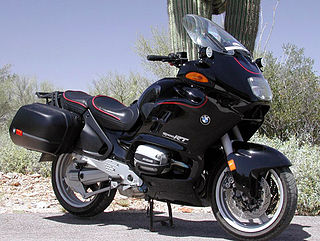
The BMW R1100RT is a BMW touring motorcycle with a horizontally-opposed twin-cylinder boxer engine. It was built from 1996 to 2001 in the BMW Berlin plant in Spandau, together with several sister models of similar design, including the R1100R, R1100GS and R1100RS, with almost identical engines but different engine tunes, trim levels and chassis details.

BMW R100, with variant models designated by T, S, CS, RS, RS Classic, RT, RT Classic, TIC, TC, R and GS is a BMW motorcycle series, using a two-cylinder four-stroke boxer engine of 980 cc capacity. Model production began in 1976, with a premature shutdown and subsequent restart in 1985, and final completion of the series in 1996.

The Ducati Panigale V4 is a sport bike with a 1,103 cc (67.3 cu in) desmodromic 90° V4 engine introduced by Ducati in 2018 as the successor to the V-twin engined 1299. A smaller engine displacement version complies with the Superbike category competition regulations which state "Over 750 cc up to 1000 cc" for three and four cylinder 4-stroke engines.
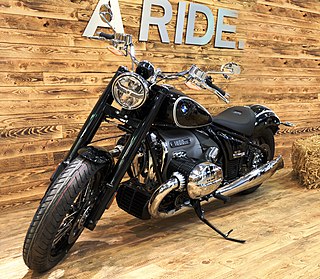
The BMW R 18 is a cruiser motorcycle manufactured by BMW Motorrad and was officially introduced in April 2020 and launched in September 2020 in Germany. Due to the COVID-19 pandemic, an official introduction at the BMW dealers was not possible, therefore it was presented virtually on the internet.


















